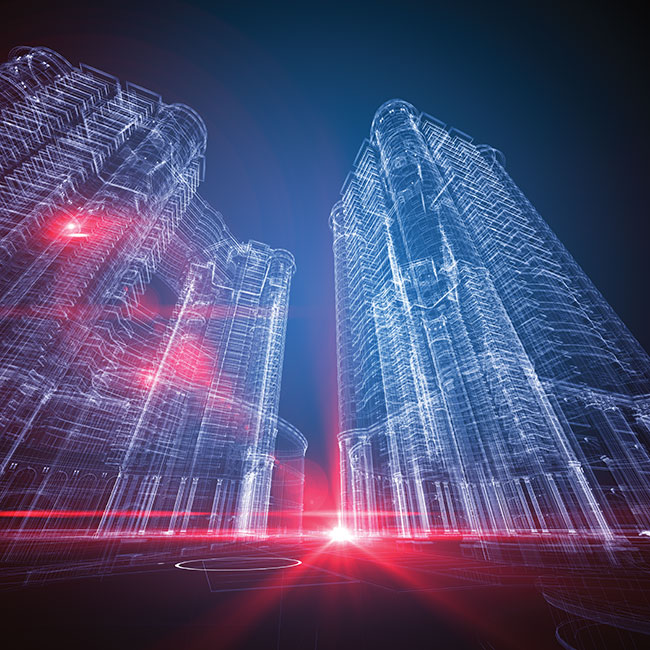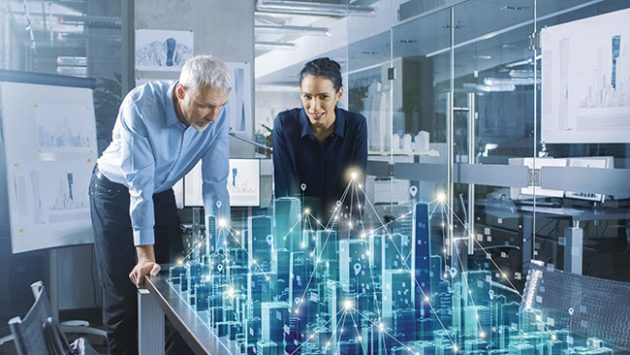
Features
Software
Digital Twins
How will this affect the glass industry?
March 24, 2021 By Andrew Snook
 © teekid / E+ / Getty Images
© teekid / E+ / Getty Images When it comes to the construction and maintenance of buildings – and the glass installed and serviced in them – architects, engineers and glaziers are always looking for the latest and greatest techniques and technologies to help improve efficiencies on their projects. One of those technologies that has been garnering a lot of interest in recent years in the world of building construction and maintenance is digital twins.
Digital twins are the latest evolution in the digital modelling of buildings, offering users and manufacturers a look in real-time at how their buildings or products are performing. A digital twin is a virtual copy of any physical object that has the ability to offer critical information to the end user as to how that object is performing.
“Think of it like an iWatch, which could be compared to a digital twin of you,” explains Jay Polding, industry account manager for Architecture, Engineering and Construction SolidCAD. “It’s taking various measurements that can be accessed in real time. The data can be tracked over a period of months or years. From a single source, a medical professional can observe key measurements, things like heart or oxygen level. Buildings, though, are much bigger and harder to see than just one person. That is the promise of the digital twin for buildings. The idea of being able to make good decisions based upon the building’s live performance data and digital 3D model.”
Building and facility managers have been reliant on software to track the performance of mechanical equipment like HVAC units and boilers for some time now, to help optimize things like energy efficiency and predictive maintenance. Digital twins bring this one step further, offering performance data in real-time of key parts of buildings with the help of sensors – windows included.
“A scenario of this may be placing temperature, moisture or movement sensors on the outside and inside of a wall system. Not only do you have a 3D digital model, but you have live information that can be monitored over time,” Polding says. “A person could open the digital twin, click on a specific sensor and get a live readout of the data. A next step may be to integrate data from those sensors into your overall building systems like HVAC, lighting, and maintenance.”
Polding says digital twins will have a growing role in building management because of its potential to help manage the energy a building is using and how efficient each aspect of that building is, such as the glass installed or the mechanical and electrical systems. Building maintenance is also an area where the digital twin can give important information of when work has been done and what work needs to be done. This is vital considering the steep price tags that come with managing almost any building.
Code Applications
“Energy and health codes are becoming more challenging to the curtainwall industry. Being able to prove how a building performs in a real-world application is important to meet those challenges” he says.
Polding says that much of the data building managers are currently receiving from existing monitoring systems would be integrated into a digital twin. A digital twin, however, takes it a step further. People are visual. In the current environment, the performance data of a building is on various dashboards, equipment readouts and reports. The collection and aggregation of this data is complex and different in almost every building type. By providing current data in the context of a digital 3D model operators and contractors who enter the building to provide service are equipped to quicky and efficiently do their job.

Digital twinning technology has the potential to identify and help manage the energy efficiency of each aspect of a building, integrating glazing with mechanical and electrical systems. © Gorodenkoff / Adobe Stock
Affecting glaziers and facade designers
“One of the biggest expenses on a curtain wall is the glass. It is very hard to make changes if it shows up to the site and doesn’t fit.” Polding says. “This is why physical prototyping is common for large and complex pieces of glass.” Two key aspects of a digital twin are already playing a crucial part in the prototyping of glass and systems. This is by using Building Information Modeling (BIM) as well as Reality Capture which includes laser, lidar and other technologies.
“One example I have seen in the industry is building envelope replacement on older, poured concrete buildings. The concrete slabs often vary in thickness and level. Being older buildings, slabs may not have been poured perfectly and have shifted over time,” he says. Scanning and modeling existing conditions is an investment that keeps on paying returns throughout the life of the project. “Manufacturing and installation should be based on reality, not somebody’s 40-year-old drawings or various on-site sketches and measurements,” he says.
Manufacturing, installation and service benefits
From the manufacturing standpoint, Polding sees an opportunity to integrate the use of sensors, shading technology and opening systems into a system which are digital twin-ready. Roof systems are also an area where data like air flow, weight and moisture level could add value to a digital twin. When installing, communication is key to address the various unforeseen challenges.
Digital twin technology is gaining traction as the pieces start fitting together. These pieces include BIM, Reality Capture, Common Data Environments like Autodesk Construction Cloud and internet-of-things connectivity sensors and software.
Autodesk announced at Autodesk University Virtual 2020 the future availability of Autodesk Tandem. Autodesk Tandem brings project data together from its many sources, formats and phases, to create a data-rich digital hub that tracks asset data from design through operations – a digital twin. There are other vendors developing for the digital twin market, too.
The impact on retrofits
U.K. construction software provider, Asite, sees a key role for digital twinning in building retrofits. In its Smart Retrofits report, it lays out five ways the technology could help achieve energy-efficiency goals when upgrading older buildings for higher performance. The first is by creating twins to collect data through sensors and identify where existing buildings are wasting energy, perhaps by heating rooms cooled by poorly performing fenestration.
Next is tracking and predicting. A digital twin model can can store data on the expected lifecycle of building components, compare it to collected use data, and update maintenance schedules, part orders and replacement alerts to streamline planning for when and where retrofits should happen. The report claims better maintenance activities can achieve 20 percent energy savings annually.
Another way twinning can help is by monitoring and modelling human activity in the building. The use of a building often changes over its life span. Occupancy loads may go up or down. Different areas may get more or less use than they did when the building was originally opened. Even more radical changes in use can happen, such as migration from commercial or industrial space to retail or even residential. The times of day when the building is occupied can change. Any of these changes can have measurable effects on energy use and demand different approaches to future retrofits. Digital twinning can help owners understand these relationships. Perhaps an area that once required substantial daylighting is no longer used during the day, making shading devices or tinted glass feasible. Maybe a room that once had office workers in it is now used for storage and doesn’t need operable windows any more.
Twinning can deliver broader sustainability in the built environment by predicting what waste will be generated by retrofit activities, allowing retrofitters to plan for recycling and reuse of the replaced materials. Many digital twin models for different buildings could be set up to share information, allowing for coordination of retrofit activities where new materials are bought in bulk and work scheduled across multiple sites. Asite also sees benefit in model owners sharing information to increase knowledge aof common sources of inefficiency.
Finally, Asite points to the potential benefit of future-proofing buildings by incorporating better resilience and longer life-spans through retrofitting. As our understanding increases of the impact of a building’s use and environment over time, including changes in climate impacts, its retrofits can be better planned to address the current needs and anticipate the needs of the future.
Conclusion
As clients are faced with more stringent health and energy codes, building a digital twin makes more sense. A fully realized digital twin may only be a few years away as the building blocks are forming quickly. This will present opportunities and challenges to the glass industry. The envelopes of the future will likely be connected to the building in a more meaningful way with embedded technology which plugs into the digital twin.
Print this page
Leave a Reply